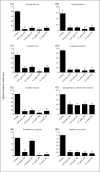Antimicrobial effect of oral care gel containing hinokitiol and 4-isopropyl-3-methylphenol against intraoral pathogenic microorganisms
- PMID: 37656688
- PMCID: PMC10473516
- DOI: 10.1371/journal.pone.0283295
Antimicrobial effect of oral care gel containing hinokitiol and 4-isopropyl-3-methylphenol against intraoral pathogenic microorganisms
Abstract
Objective: Deterioration of oral hygiene is closely related to an increase in severity and mortality of corona virus disease-19 (COVID-19), and also contributes to the development of various diseases such as aspiration pneumonia or Alzheimer's. Oral care is attracting high interest in Japan, which has entered a super-aging society. In this study, we aimed to investigate whether commercially available Hinora® (HO), an oral care gel containing hinokitiol and 4-isopropyl-3-methylphenol (IPMP), has biofilm formation inhibitory and antimicrobial activities against various intraoral pathogen microorganisms.
Method: Candida species, Aggregatibacter actinomycetemcomitans, Staphylococcus aureus, and Pseudomonas aeruginosa were selected during the study period, all of which were analyzed using antimicrobial disc, microorganism turbidity, and crystal violet assays. In addition, the germ tube test using Candida albicans (C. albicans) was performed with a modification of Mackenzie's method. Images for morphological observation of the germ tubes were acquired using an inverted microscope. For comparison between products, we used Refrecare® (RC), which only contains hinokitiol (not containing IPMP).
Results: All the intraoral pathogenic microorganisms showed drug susceptibility against undiluted forms of HO and/or RC. In particular, HO was more effective at lower concentrations than RC. In the HO-added group, inhibition circles were observed in all bacteria except P. aeruginosa when added at a concentration of 0.5 g/mL or more. The optical density values at 590 nm (crystal violet) and/or 600 nm (microorganism turbidity) of all the fungi and bacteria were significantly lower when cultured in medium with HO. Inhibition of growth or biofilm formation was observed when HO was added at a concentration of 0.05 g/mL or higher. To investigate the action mechanism of HO, germ tube tests were performed in C. albicans. The results showed that culturing C. albicans in soybean-casein digest broth with HO (0.05 g/mL) significantly suppressed germ tube formation.
Conclusions: These data suggest that oral care gel-containing hinokitiol and IPMP has strong biofilm formation inhibitory activity, as well as antifungal and antimicrobial effects against Candida fungi and multiple intraoral pathogenic microorganisms. Therefore, it may be a promising treatment option for oral infections.
Copyright: © 2023 Ohara et al. This is an open access article distributed under the terms of the Creative Commons Attribution License, which permits unrestricted use, distribution, and reproduction in any medium, provided the original author and source are credited.
Conflict of interest statement
I have read the journal’s policy and the authors of this manuscript have the following competing interests: We received a research grant from Otsuka Pharmaceutical Co., Ltd. to conduct and advance this research.
Similar articles
-
Studies on the antifungal effects of Hinokitiol on Candida albicans: inhibition of germ tube formation and synergistic pharmacological effects of miconazole.Odontology. 2025 Apr;113(2):556-565. doi: 10.1007/s10266-024-00992-4. Epub 2024 Sep 18. Odontology. 2025. PMID: 39292415
-
The effect of subinhibitory concentrations of gentian violet on the germ tube formation by Candida albicans and its adherence to oral epithelial cells.Arch Oral Biol. 2017 Oct;82:1-5. doi: 10.1016/j.archoralbio.2017.05.016. Epub 2017 May 25. Arch Oral Biol. 2017. PMID: 28575640
-
In vitro antimicrobial and anticancer potential of hinokitiol against oral pathogens and oral cancer cell lines.Microbiol Res. 2013 Jun 12;168(5):254-62. doi: 10.1016/j.micres.2012.12.007. Epub 2013 Jan 11. Microbiol Res. 2013. PMID: 23312825
-
Candida and candidaemia. Susceptibility and epidemiology.Dan Med J. 2013 Nov;60(11):B4698. Dan Med J. 2013. PMID: 24192246 Review.
-
Morphological characteristics of Candida albicans, Candida krusei, Candida guilliermondii, and Candida glabrata biofilms, and response to farnesol.Vet World. 2021 Jun;14(6):1608-1614. doi: 10.14202/vetworld.2021.1608-1614. Epub 2021 Jun 22. Vet World. 2021. PMID: 34316210 Free PMC article. Review.
Cited by
-
Synergetic inhibitory effect of isopropyl methylphenol-based agents on biofilm formation by Streptococcus mutans.PLoS One. 2024 Sep 23;19(9):e0310926. doi: 10.1371/journal.pone.0310926. eCollection 2024. PLoS One. 2024. PMID: 39312550 Free PMC article.
References
Publication types
MeSH terms
Substances
LinkOut - more resources
Full Text Sources
Medical





